Apple's 2010 MacBook Air (11 & 13 inch) Thoroughly Reviewed
by Anand Lal Shimpi on October 26, 2010 10:08 PM EST- Posted in
- Mac
- Apple
- MacBook Air
- Laptops
The 13
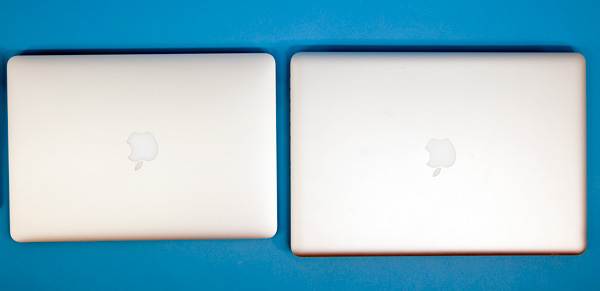
13-inch MacBook Air (left) vs. 15-inch MacBook Pro (right)
The 13-inch MacBook Air feels more like a regular notebook. It’s like one of those cartoons where you see the character straight on and he looks normal sized, but turn him 90 degrees and he’s pencil thin. When viewed from above you’d think you had a 13-inch MacBook Pro on your desktop. Its footprint isn’t that different:

But pick it up and you’re dealing with a much thinner notebook. Like the 11-inch MBA, the 13-inch model ranges from 0.11 inches to 0.68 inches in thickness. You get the same angular ID from the 11-inch model, just on a bigger scale.

13-inch MacBook Air (left) vs. 15-inch MacBook Pro (right)
The underlying hardware is unchanged, although you do get a noticeably quicker CPU. While the 11-inch model ships with a 1.4GHz Core 2 Duo (3MB L2 cache, 800MHz FSB), the 13-inch model comes with a 1.86GHz part by default (6MB L2 cache, 1066MHz FSB). I call it a noticeably quicker CPU because it is noticeably quicker, even in typical day to day use.
The 13.3-inch diagonal screen features a 1440 x 900 display (16:10 ratio). That’s the same screen resolution as the 15-inch MacBook Pro but in a smaller package. And it really makes a big difference when it comes to getting work done on the MacBook Air. This is a big improvement over the limited 1280 x 800 found in the previous two MacBook Airs and a high enough resolution to actually get work done on.
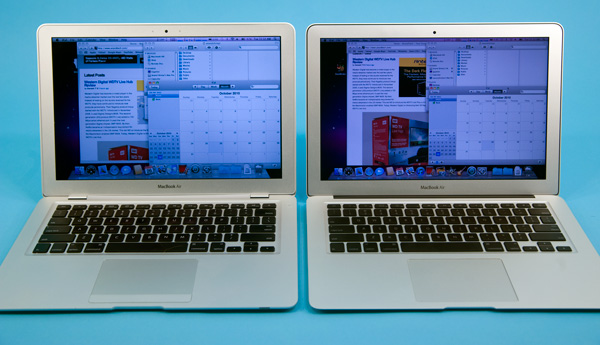
The old 13-inch MacBook Air (left) vs. the new 13-inch MacBook Air (right)
I’d go as far as to say that Apple could’ve bumped pixel density even further and the 13-inch MacBook Air would still be useable.
The 13-inch screen is a bit brighter and has a slightly better contrast ratio than the 11-inch, but it’s not something you’ll notice in use. The same vertical viewing angle limitations apply here. Unlike the 11-inch model however, you’re more likely to notice them because of the size of the display. On a plane when the passenger in front of you leans back all the way you’re probably going to have to angle the 13-inch display, while the 11-inch model may give you enough room to clear.
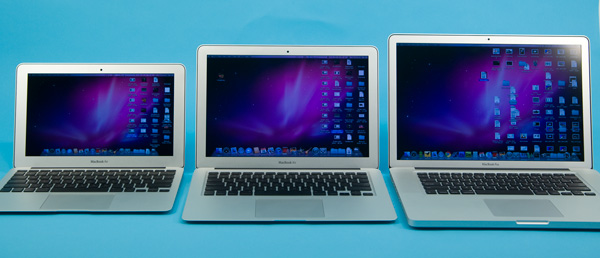
From left to right: 11-inch MBA, 13-inch MBA, 15-inch MBP
The trackpad on the 13-inch model is a taller rectangle, identical in size to what you’d find on a MacBook Pro. The wrist rest area is also normal-sized. In fact, other than the thickness there’s very little that separates the 13-inch MacBook Air from a 13-inch MacBook Pro.
Apple integrated an SD card reader with the 13-inch MBA which further identifies its light workhorse nature. It’s a nice addition that does make the MacBook Air more useful if you have a camera that uses SD cards (*grumbles at the D700*). The rest of the ports are unfortunately just as limited as the 11-inch model, but if you really want an Ethernet port you can either go the USB route or you can get a MacBook.
The stereo speakers are an improvement over the original MacBook Air. The old mono speaker was horrible to listen to. Now you've got two of them, which somehow makes the sound better. This isn’t exactly a set of Klipsch drivers but you get far less of a laughable sound out of them than before
The keyboard is identically sized to the 11-inch. You get larger function keys but there’s still no backlight. The backlit keyboard continues to be the biggest miss from the old MacBook Air.
Apple calls the new MacBook Air the future of the MacBook. If we take that literally it could mean that all future MacBooks will be the Air. Pro users will simply buy the bigger machines if they need the added performance, but the majority of users could get by with the Air. I tend to agree with this philosophy. There’s really no reason to get the base MacBook. The 13-inch MBA sacrifices a bit of performance and expansion, but you get a far more portable machine. For users who need the performance, there's always the Pro line.


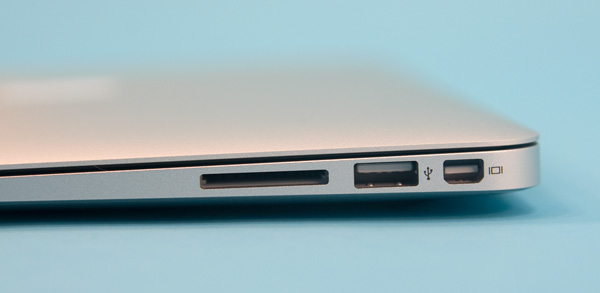
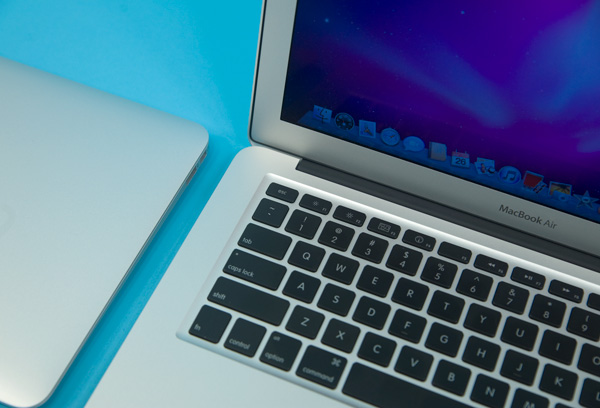








185 Comments
View All Comments
quiksilvr - Wednesday, October 27, 2010 - link
The answer:Combined, they will be much less than $800.
THe BRD is an option to add-on, so generally speaking, the normal trend is ~50% higher than the cost for the manufacturer to purchase and install it.
And they can use ANY LV, ULV chip. Start at the lowest and give options for US to choose how high we can go.
The design obviously will be altered somewhat for the ExpressCard slot, but the more I think about it, the more unnecessary it is in this day and age. USB 3.0 will give the speeds. (Also, USB 3.0 controllers aren't ZOMG expensive, they are relatively cheap)
And its not 11, 13, and 15, its 11.6", 13.3" and 15.4" (and 17"). Seriously, 12", 14" and 16" is the best. You hit all three markets: the ultraportable, the general usage, and desktop replacement.
And finally: stop being a douche and lets have a debate rather a name calling contest. Seriously, you wasted a run-on sentence on TARDIS and TARD?
solipsism - Wednesday, October 27, 2010 - link
Again, you've failed to even do the most rudimentary of research or cognitive thinking but somehow came to an $800 retail price point.Intel list their price per 1000 units of LV and ULV chips, and other vendors do sell 9.5mm BRDs (though not the more expensive slot-loading drives, as far as I can tell), and those two items alone are about $800. That's only two components and doesn't include any other costs or a profit margin.
Then you've ignored Apple's choice to focus on slim deaigns. You may not like it (I certainly don't as an 11" MBA with double the battery would be more ideal for my needs) but you need to accept it. Saying "they don't have to make their machines so thin" is a strawman argument so don't even go there.
Seriously, trying looking at actual HW on the market that Apple would potentially use, then price it. Grabbing a price for adiaplay base solely on resolution is pointless. Grabbing a price of a BRD that doesn't fit the space is pointless. Conclusion, your response will likely be pointless.
quiksilvr - Wednesday, October 27, 2010 - link
*takes deep breath*...A Blu ray drive OPTION (NOT STANDARD). The customer will pay for it if they so choose and there are slot load blu ray drives out there from Panasonic, Sony and even Dell.
They don't have to be 9.5 mm they can be 12.7 because the Macbooks (not the Airs, which will not have an optical drive) are ~25 mm thick.
And the slot load Blu Ray DRIVES run for ~$100:
http://www.google.com/products/catalog?hl=en&q...
The slot load Blu Ray BURNERS run for around $250:
http://www.dectrader.com/466803-001-New-HP-4X-Blu-...
So to maintain profits, they would charge $150 for the drive and $350-$400 for the burner.
As for LV and ULV, the most expensive chip I found (ULV cost more than LV) is the Core i7-680UM which runs $317 (if you buy 1000, which I'm sure Apple can afford):
http://ark.intel.com/Product.aspx?id=49664
I think it will be safe to assume (unless you object otherwise) that the ultra low voltage Core i3s and i5s will be noticeably cheaper.
I don't spout out statistics because the information is quite literally a Google search away. I LITERALLY wrote "slot load blu-ray drive" and got those retailers.
quiksilvr - Wednesday, October 27, 2010 - link
Sorry, wrong link. The Blu ray BURNERS cost around ~$350 (damn, no wonder retailers don't sell these in laptops)http://www.amazon.com/DIGISTOR-Blu-ray-Burner-Slot...
So to make it marginally profitable, it would be ~$450-$500 to ADD onto the BASELINE Mac product.
solipsism - Thursday, October 28, 2010 - link
OMG! This guy actually posts a link to a desktop-grade BRD that costs over $350 and suggests it for a Mac notebook that can only take a 9.5mm ultra-slim drive!SERIOUSLY, WTF IS WRONG WITH YOU?!
You have ignored my list of sensible questions to you regarding viability and psychics, and have nonsensically claimed that Apple doesn’t use quality components when even AnandTech, one of the most neutral tech sites around clearly show that the LCD, trackpad and many other aspects are better than the competition.
Look, you don’t have to like a company or their products, but to allow a modicum of common sense into your posts when you claim to be the only sensible one posting is insane. Really, it’s fraking crazy!
quiksilvr - Thursday, October 28, 2010 - link
Siiiiigh.If you clicked the third image, you can clearly see that the HOUSING is what is 43mm and not the drive itself. You can actually see below the connector all that empty space under it.
And things like the trackpad and LCD (especially on 11 and 13" screens) are not much more expensive (do you really want to go through every single minute component just so I can prove to you that it doesn't even come close to the costs I suggested?)
I showed the pricing of the ULV and LV chips are (or at least what the absolute maximum will be for the one that the customer will pay extra for), it has already been established that the RAM, the memory, the screen and the GPU are available on other products for less, and I showed you the Blu ray Drive (the oh so fancy slot one that people want) that ISN'T EVEN STANDARD ON THE BASELINE I RECOMMENDED.
I don't like the company because the company's pricing doesn't make sense. Yes the unibody aluminum is great. I like solid construction. The weight and thinness isn't really a big deal for me, but that doesn't negate the fact that it costs extra and takes effort.
Should Mac products cost more? Of course. But the extent of their pricing lacks common sense and the only reason they are selling so damn well is because consumers have been brainwashed by their marketing tactics and "trend" setting. It makes me sick to my stomach that such a company has made $51 billion dollars over these products.
darwinosx - Tuesday, November 2, 2010 - link
You are not factoring in their far superior service, which cost money, their higher hardware quality control standards, which costs money, the fact that they write their own OS instead of just slapping whatever mediocrity Microsoft is slinging these days, their own hardware design, higher quality hardware manufacturing, or the fact that you are clueless.ImSpartacus - Wednesday, October 27, 2010 - link
I don't think Apple can make those kinds of prices. There are a lot of things that go into a macbook that just aren't found in other laptops.-Giant trackpad
-Decent LCD
-Large battery
-Exceptional build quality
When you cram superior laptop components into a smaller package, it will undoubtedly be more expensive.
darwinosx - Tuesday, November 2, 2010 - link
You have no idea what you are talking about. Back to Mommy's basement.tim851 - Wednesday, October 27, 2010 - link
>>I know this will never happen because it makes too much senseGotta love it when somebody comes along and makes a "more sensible" pricing suggestion to the far and wide most profitable PC hardware manufacturer in the world and the gist of it is: price it more like those competitors that outsell you but earn less money doing it.
You're a genius! You should make the same suggestion to Ferrari: Guys, you can move a whole lot more cars if you just make them cheaper!
For ten years people have been saying that Apple needs to get cheaper. All the while they became ever more successfull. They might technically not be the no.1 computer maker, but they have a higher net income than the rest of the top 10 (probably even top 20) COMBINED. So the last thing they need to do is make their stuff cheaper.